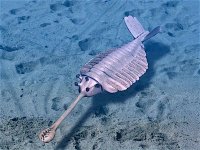Subsymbolic
Screwtape
- Joined
- Nov 23, 2017
- Messages
- 806
- Location
- Under the Gnomon
- Basic Beliefs
- Beliefs are an ancient theory of brain content which would be ripe for rejection except it's the idiom in which we came to know ourselves and thus elimination is problematic. We make it up from there
Just read this. While it's quite convincing evidence that life developed off world, I'm unsure that the conclusion of the paper, that life is common across the universe, is warranted.
https://www.sciencedaily.com/releases/2017/12/171218154925.htm
A theory that has been gaining credence over the last few years involves low temperature development of the prebiotic basis for life, even life, in comets, where the freezing action effectively reduces the water in the equation and drives surprisingly fast processes at high concentration and low temperature. The idea is that, as the comets circle the sun you have long periods of frozen dormancy and shorter periods of 'goldilocks' activity. This could allow for an extended period of evolution before hitting Earth and seeding the oceans with life, or advanced precursors of life, which could have seeded the deep ocean vents. I really like this two stage solution, because it has the same basic processes repeatedly occurring with rather a large range of variations. Twice.
While this is still pretty fanciful at this stage, it's still has more parsimony than proposing life is common in the cosmos.
https://www.sciencedaily.com/releases/2017/12/171218154925.htm
A theory that has been gaining credence over the last few years involves low temperature development of the prebiotic basis for life, even life, in comets, where the freezing action effectively reduces the water in the equation and drives surprisingly fast processes at high concentration and low temperature. The idea is that, as the comets circle the sun you have long periods of frozen dormancy and shorter periods of 'goldilocks' activity. This could allow for an extended period of evolution before hitting Earth and seeding the oceans with life, or advanced precursors of life, which could have seeded the deep ocean vents. I really like this two stage solution, because it has the same basic processes repeatedly occurring with rather a large range of variations. Twice.
While this is still pretty fanciful at this stage, it's still has more parsimony than proposing life is common in the cosmos.


